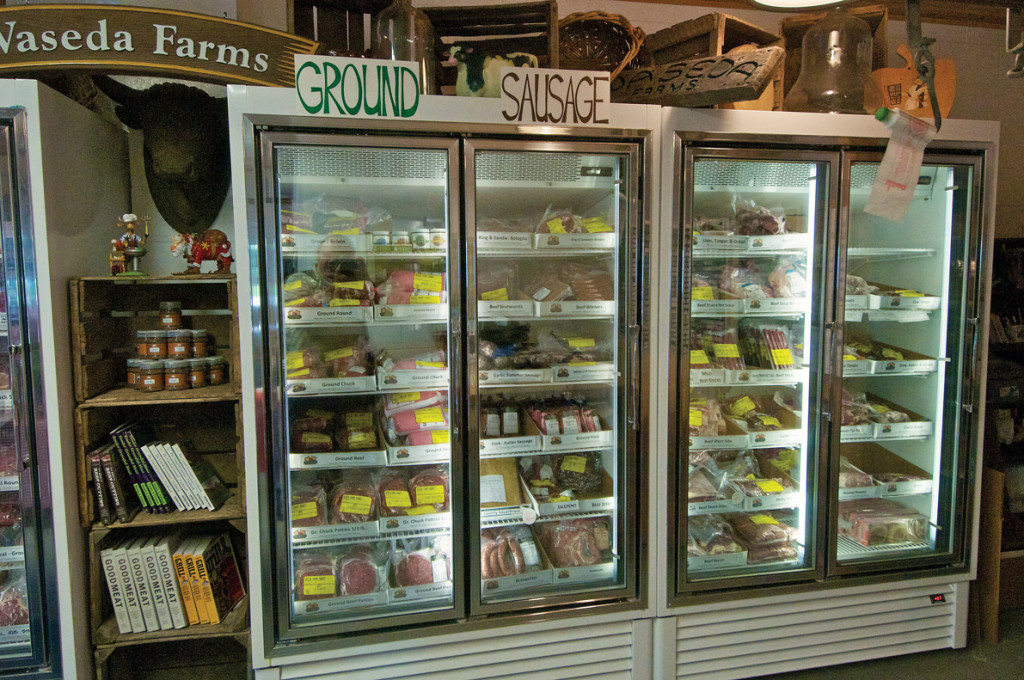Going Against the Grain at Waseda Farms
- Share
- Tweet
- Pin
- Share

For most of his life Tom Lutsey didn’t pay much attention to his diet. He liked his steaks, had his favorite hamburger spots in Door County, and loved to stop for a couple of the famous burgers at Kroll’s in Green Bay.
He was running his family’s hugely successful ice cream business, Gold Bond Ice Cream, in Green Bay, which created such products as the Choco Taco, and then he started paying the price for a stressful work life and a diet heavy in red meat.
First came a couple of heart attacks. That was enough to persuade him to scale back his workload. The ice cream business was soon sold to Unilever.
“It was better for me and for the kids if I spent more time with them,” he says.

Cattle at Waseda Farms are grass-fed and raised in the Temple Grandin style. Photo by Len Villano.
His company bought the Hanson’s dairy stores in Green Bay and ran those for a while before selling them off. Then Tom was diagnosed with cancer, Non-Hodgkins Lymphoma.
He went through chemotherapy and beat it. By then he and his wife Sharon had bought a small farm in West Jacksonport. They lived in Green Bay, but she wanted to spend more time on the Door Peninsula, where they had a home in Egg Harbor; Tom said if they were going to do that, they needed something to do.
The farm became his place to recuperate from chemo. It was then that his dietician told him he needed to cut way back on his red meat consumption. If it would help his health, he would do it.
Tom, however, started reading books like Michael Pollan’s The Omnivore’s Dilemma, and he read about the state of the American food system – about the hormones and antibiotics injected into our beef and the chemicals lathered on their food, a grain diet they would never eat if given the choice. He wanted the good stuff and decided there was no one better to raise his beef than himself.
He bought a few cattle and worked with a neighboring West Jacksonport farm to raise them. He soon bought a couple more, and his farm started to grow.
Then the cancer returned. This time it took a stem cell transplant to save him, but his dedication to a new diet, a new food philosophy, was also growing. His farm had outgrown its West Jacksonport property and Tom and Sharon’s eyes wandered to an underused plot near Kangaroo Lake in Baileys Harbor owned by the Priests of the Sacred Heart.
With Sharon’s encouragement he bought the 360 acres. His cancer had sparked the creation of Waseda Farms, possibly the peninsula’s most unique farming operation.
Good Soil, Good Beef
“Farmer Tom,” as his wife is prone to calling him, is a calm man. Deliberate in his speech, he can get caught peering over his wispy curl of a mustache and admiring his animals for long stretches.
It’s a trait perfectly suited to Waseda Farms, which stretches through one of the most beautiful expanses of land on the peninsula along Logerquist Road. The farm is 100 percent organic, down to the cedar fence posts that line the fields. The beef is grass-fed, rotated amongst the fields of grasses and legumes.
Still, one can’t describe what Tom Lutsey is trying to do just by calling Waseda an organic farm, or labeling his meat as grass-fed. What he and his staff are doing runs deeper than that.
In his research Tom learned about Temple Grandin, a nationally-renowned advocate for animal welfare who has spent much of her life devising ethical ways to use animals for food by giving them “a decent life” and a “painless death.”
Lutsey called Grandin to consult with her about his farm. He installed a cattle-handling system designed by Grandin and partner Mark Deesing that reduces animal stress as they are led to slaughter. The corral is designed with a curved chute that begins wide and narrows, so the cattle can’t turn around or see outside the chute, eliminating stressful cues. Workers guide them not with prods, but with rattles.
These cows don’t go to the butcher, they go to “Freezer Camp.”
“If we spend all these months raising them with no stress, then right before we send them to camp we prod and scare them, we’re going to send the adrenaline rushing to the meat right before they’re butchered,” Tom says. “That hurts the meat.”
The meat, however, begins with the soil.
Tom drives me in his golf cart to a field in the middle of the farm, down at the bend of a long dirt path lined by trees and decades of rock picking. It’s mid-June and already the summer’s dry weather is taking its toll – though Tom drives slow the cart still kicks up waves of dust.
He stops to let a group of young kids from St. Joseph’s Catholic Retreat hike by without dust hitting them. The farm was once part of the retreat, and a large wooden cross stands proudly on a hill at the highest point on the farm, visible from County Highway A. Lutsey continues to let visitors to the retreat use his paths to visit the cross and hike the grounds.
After they pass we stop at the bend and Tom walks me into the pasture, unhitching two links of electric fence to let us in. A few yards in Tom squats close to the ground, pulling the grass apart to expose the soil and digging his fingers into the decomposing grasses at the base of the green stuff.

Signs of the Catholic retreat that used to call the farm home remain. Photo by Myles Dannhausen Jr.
“This is what I love,” he says. “This insulates it and keeps moisture in it. It’s not a ton, but it does a little. I want to see years and years of that buildup. That’s nutrients there.”
He picks a few blades, showing me where the cows chewed down the grass days before. Around us are some noticeably darker patches of green – spots where cow pies were dropped but not spread, providing evidence of just how powerful the manure is as a fertilizer.
Tom says it will take another seven years for the soil to build up to where he wants it to be, to an entire field of lush green, built entirely through natural practices.
This year he added an egg-mobile, a large chicken coop on a trailer. The organically raised chickens lay eggs in a 20-foot hut, but that’s not their most important job. A couple of days after the cows graze in a field, farm manager Chris Shuh will pull the egg-mobile through the pasture. The chickens will walk down the ramp behind the coop to forage into the manure for larvae, naturally spreading the cow pies and contributing their own nitrogen-rich waste to the soil.
Later the field will be dragged with huge tractor tires laid on their side to knock down the piles and spread the mixture more evenly.
Jo Robinson, the Washington state-based founder and director of EatWild.com, a website preaching the virtues of grass-fed beef and other organic foods, said such practices speak to the value of pasture-raised beef.
“What other farming method do you know that makes the soil better and better and better year after year?” she asks rhetorically.
The Waseda process runs contrary to the quick fix mentality that permeates so much of American culture, from medicine to agriculture. Lutsey could swamp his fields with industrial fertilizer, but that would enrich the soil for one year before he would have to apply it again the following season. What he’s trying to build is a sustainably rich base.
“There are no shortcuts,” he says. “I want to put the nutrition back in the ground that stays there. When a conventional farmer puts liquid fertilizer on the ground to grow the crop this year, the crop grows and that nutrition’s gone. We’re not doing that. We’re putting it down so next year’s soil retains it.”
Tom is not young. He’s fought cancer off twice and bounced back from heart attacks. He’s realistic about his health. It will probably take 10 to 15 years before the farm matures into what he thinks it can be.
“I probably won’t be here to see it,” he says. “My sons should be the ones who benefit from this.”
Spreading the Message
One of those sons, Matt, was not surprised when his parents told him they were buying the farm.
“My dad always has to have something going on. He’s not the type to just retire and play golf every day,” Matt says. “That’s not how he works. He’s as passionate about this farm as he is about anything. When he’s away from the farm all he wants to do is get back to it.”
Matt, a 36-year-old with a culinary background that has included stints around the country, now lives in Green Bay and handles the marketing end of the business (his brother, Andrew, helps with the financial end). His role also includes tempering his father’s ever-growing vision, one that grew to include pigs last year.
“My dad is a big picture guy, a dreamer,” Matt says. “If I let him go every direction he wanted, we’d have a zoo there.”
Tom’s family and staff express a mix of admiration and exasperation when talking about him. Eyes roll and bemused smiles creep across their faces when talking about his next project, be it the egg-mobile, the addition of the pigs, or other ideas to grow the farm.
Matt didn’t think his Dad was going to make a business out of the farm, and he certainly didn’t anticipate returning to nurture it, but life has a way of taking you places you never thought you’d go, even if that place is back home.
“It is hands down one of the most rewarding things I’ve ever done because of what we’re trying to do,” he says. “That’s not to say there aren’t times I’d like to pull my hair out – I am working with my father – but life changes as you get older.”
A big part of Matt’s role is education, a theme his mother and father come back to often when talking about the farm. In May they reached an agreement to provide beef to Gibraltar School’s lunch program, working with the school to teach kids about where their food comes from and how it is raised.

The Lutseys also operate a farm market at Waseda Farms, where they sell their meat and vegetables grown there. Photo by Len Villano.
“I can’t believe there are still so many people who don’t even know what organic is,” Matt says, noting that he’s asked about it several times at every farmers’ market he attends. “We have to educate people about why it’s better for health and the environment, why organic costs 5 to 40 percent more than conventionally-raised beef.”
He’s excited at the growth possibilities for the organic sector, especially as more people investigate the origins of their food and how it’s raised.
“People are never going to say, ‘You know what I want? I want more antibiotics and more chemicals in my food,’” Matt says. “We’re not going to go further back into that. When the costs converge more, it’s going to grow. But for now, the ConAgras and Monsantos have the lobbying money to skew legislation like the Farm Bill in their direction. It will take 10 years to make a dent in that.”
Tom says that in this instance the education isn’t needed in classrooms, but in the world of his generation.
“This is a food movement that you kids have started,” Tom says, turning his head from the trail to look directly at me through his sunglasses. “Go to the Capitol Square in Madison to the farmers’ market, or go to the Harvest Restaurant across the street. You kids figured it out first.”
Tom believes wholeheartedly in his methods, but he doesn’t denigrate those who do it differently. He says he can’t be compared to a farming family like the Haberlis of Egg Harbor, whom he calls a “tough farming family. Farming is hard work, any way that you do it. Dairy people are the hardest working people alive.”
“I have no criticism of farmers who chose to do [confinement farming] because that fed the nation,” he continues. “Now we have to decide if that’s how we want to go the rest of our lives, raising our kids and feeding ourselves.”
In his second life as a farmer, Tom Lutsey has made his choice.
Why Eat Grass-Fed?
Eating organic and switching to grass-fed beef didn’t cure Tom Lutsey’s cancer. His doctors don’t know what caused it in the first place. So why does he, and a growing number of consumers, believe grass-fed beef is better for you?
Jo Robinson of EatWild.com has spent the last 14 years researching the pros and cons of eating grass-fed beef. She analyzed three decades of research to conclude that grass-fed beef has several significant health advantages over conventional beef.
For one, organic grass-fed beef has no hormones or antibiotics, and the animals feed on grass that hasn’t been grown with fertilizers or sprayed with chemicals.
A grass diet, a cow’s natural food source, produces beef high in CLA, a healthy fat that fights cancer better than any other natural substance that has been tested, Robinson says.
Grass-fed beef is lower in calories, has more vitamins A and E, more omega-3 fats, antioxidants and more beta-carotene than grain-fed beef.
It’s almost always significantly more expensive, however, and it can be tougher to cook and less flavorful to a palate indoctrinated with grain-fed beef. Robinson says about half the beef available 10 years ago wasn’t very good.
“It’s not easy to get enough fat on an animal without grain,” she explains. “You can’t take one of those big rangy animals that we’ve invented and feed them on grass. Now the farmers have learned they need special breeds, old breeds. The beef is getting better and better every year.”
The grass-fed movement is growing astoundingly fast. When Robinson began her research in 1998 she says nobody was talking about grass-fed beef. In 2002 her site listed 50 grass-fed beef sources in the entire country. Today her site lists over 2,500.
Proponents of grain-fed beef argue that the push for grass-fed beef is foolish, since even with the rapid growth it only constitutes three percent of the nation’s beef diet. Robinson, however, says such an all-or-nothing philosophy “is just a classic error in logic.”
“If a bus full of kids went off a bridge and you only had two boats, would you not rescue any of them because you couldn’t rescue them all?” she asks.
She believes we could get up to 25 percent of our beef needs from grass-fed farms. To get more would require a dramatic shift in our expectations and agricultural policies, which currently subsidize grain production, bringing down the cost of grain-fed beef.
Beef By The Numbers
50
The number of U.S. grass-fed beef producers in 2002
2,500
The number of U.S. grass-fed beef producers today
3
Percent of all beef sales that come from grass-fed cows
Sources: Eatwild.com; United States Department of Agriculture
Photography by Len Villano.





